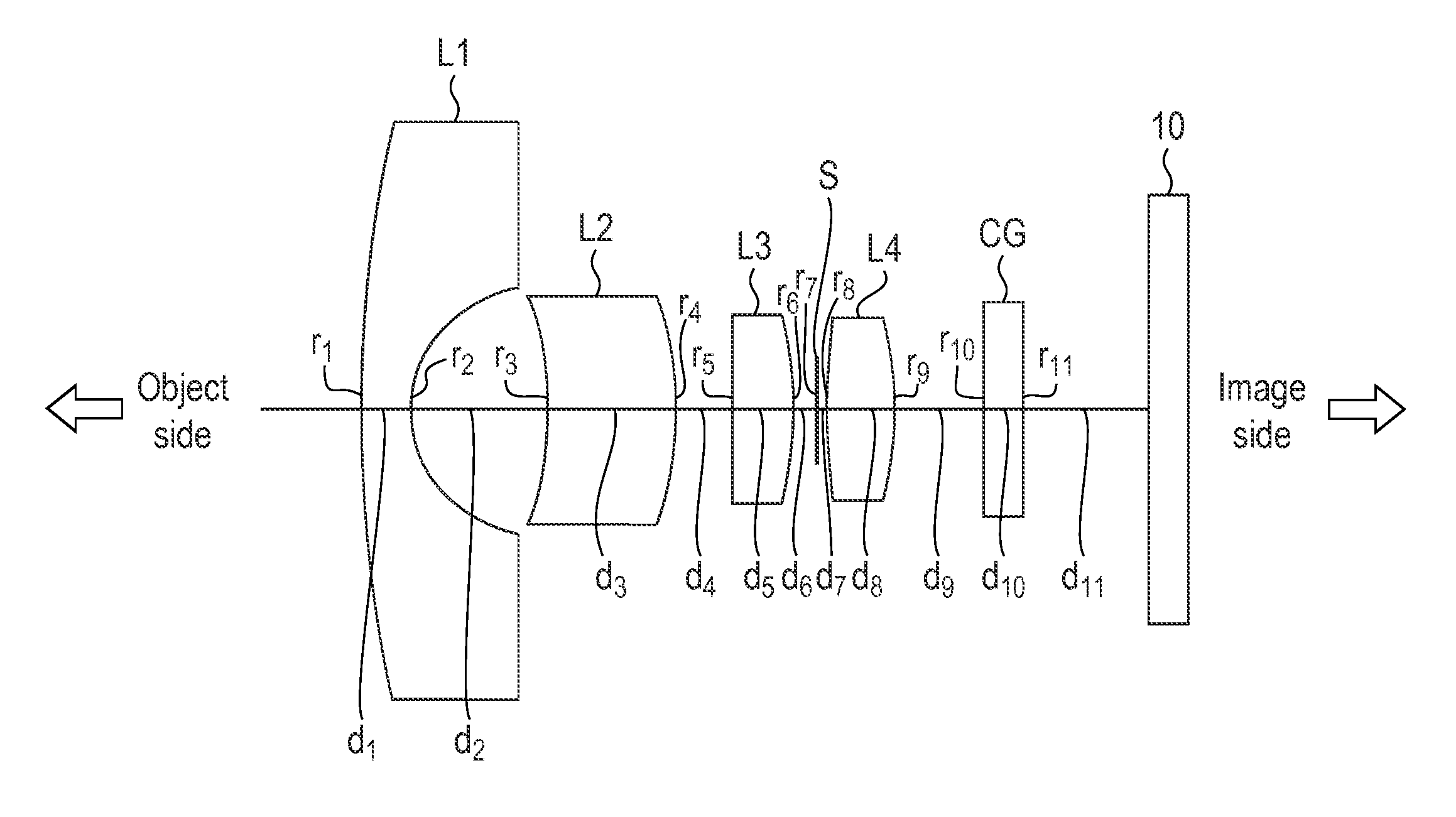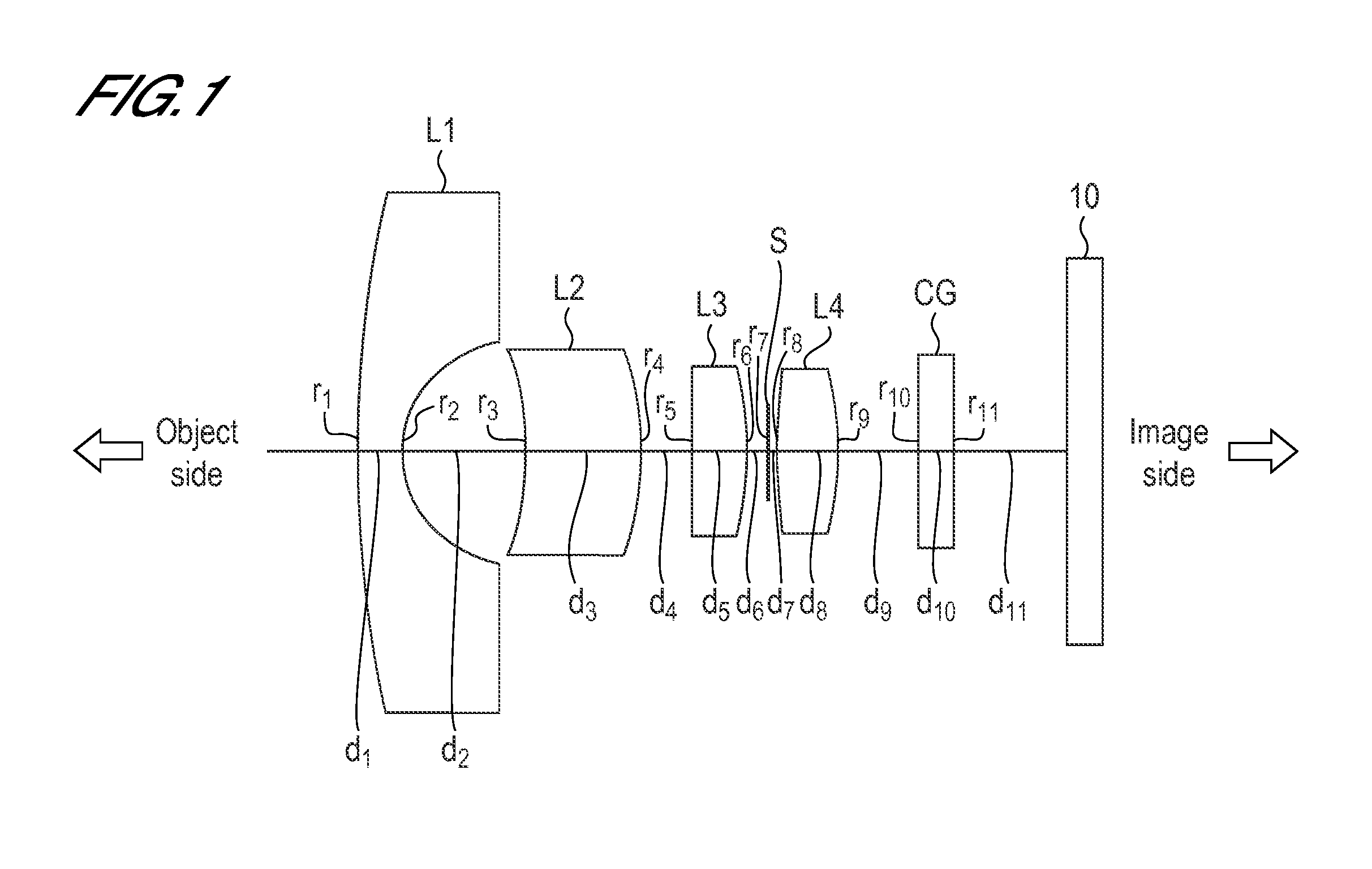Wide-angle lens and system enclosing wide-angle lens
a wide-angle lens and system-enclosed technology, applied in the field of wide-angle lenses, can solve the problems of difficult to reduce the effective aperture of the first lens, insufficient correction of chromatic aberration for both the first and the second lenses, and insufficient compactness of the wide-angle lenses, etc., to achieve high performance and high performance.
- Summary
- Abstract
- Description
- Claims
- Application Information
AI Technical Summary
Benefits of technology
Problems solved by technology
Method used
Image
Examples
first embodiment
[0074]FIG. 1 is a diagram depicting a configuration of a wide-angle lens according to an embodiment of this invention. The symbols of the surface number, surface distance or the like defined in FIG. 1 are commonly used for FIG. 2, FIG. 6, FIG. 10 and FIG. 14. In FIG. 1, the aperture portion of the aperture stop is indicated as a segment. This is because in order to define the distance from the lens surface to the aperture stop surface, the intersection of the aperture stop surface and the optical axis must be clearly indicated. In FIG. 2, FIG. 6, FIG. 10 and FIG. 14, which are optical path diagrams of the imaging lenses of Example 1-1 to Example 1-4 respectively, the aperture portion of the aperture stop is opened, and the main body of the aperture stop, for blocking light, is illustrated using a half line starting at the edge of the aperture portion, unlike FIG. 1. This is because the aperture portion of the aperture stop must be shown in an opened state, in order to draw such rays...
example 1-1
[0094]FIG. 2 is a cross-sectional view depicting a wide-angle lens according to Example 1-1. As FIG. 2 illustrates, the wide-angle lens of Example 1-1 comprises, in order from the object to the image, a first lens L1, a second lens L2, a third lens L3, an aperture stop S and a fourth lens L4.
[0095]The first lens L1 is meniscus lens having negative refractive power, of which convex surface faces the object. The second lens L2 is a meniscus lens having positive refractive power, of which convex surface faces the image. The third lens L3 and the fourth lens L4 are lenses having positive refractive power. Both surfaces of the second lens L2 and both surfaces of the third lens L3 are aspherical. As FIG. 2 illustrates, in the wide-angle lens of Example 1-1, the back focus bf with respect to the focal length 1.00 mm is 1.981 mm in a state where the cover glass CG is inserted. In other words, a sufficient length of back focus is secured.
[0096]The full aperture F number is 2.60, that is, the...
example 1-2
[0104]FIG. 6 is a cross-sectional view depicting a wide-angle lens according to Example 1-2. As FIG. 6 illustrates, the wide-angle lens of Example 1-2 comprises, in order from the object to the image, a first lens L1, a second lens L2, a third lens L3, an aperture stop S and a fourth lens L4.
[0105]The first lens L1 is a meniscus lens having negative refractive power, of which convex surface faces the object. The second lens L2 is a meniscus lens having positive refractive power, of which convex surface faces the image. The third lens L3 and the fourth lens L4 are lenses having positive refractive power. The object side surface of the first lens L1, both surfaces of the second lens L2, and both surfaces of the third lens L3, are aspherical. As FIG. 6 illustrates, in the wide-angle lens of Example 1-2, the back focus bf with respect to the focal length 1.00 mm is 1.978 mm in a state where the cover glass CG is inserted, in other words, sufficient length of back focus is secured.
[0106]...
PUM
 Login to View More
Login to View More Abstract
Description
Claims
Application Information
 Login to View More
Login to View More - R&D
- Intellectual Property
- Life Sciences
- Materials
- Tech Scout
- Unparalleled Data Quality
- Higher Quality Content
- 60% Fewer Hallucinations
Browse by: Latest US Patents, China's latest patents, Technical Efficacy Thesaurus, Application Domain, Technology Topic, Popular Technical Reports.
© 2025 PatSnap. All rights reserved.Legal|Privacy policy|Modern Slavery Act Transparency Statement|Sitemap|About US| Contact US: help@patsnap.com



